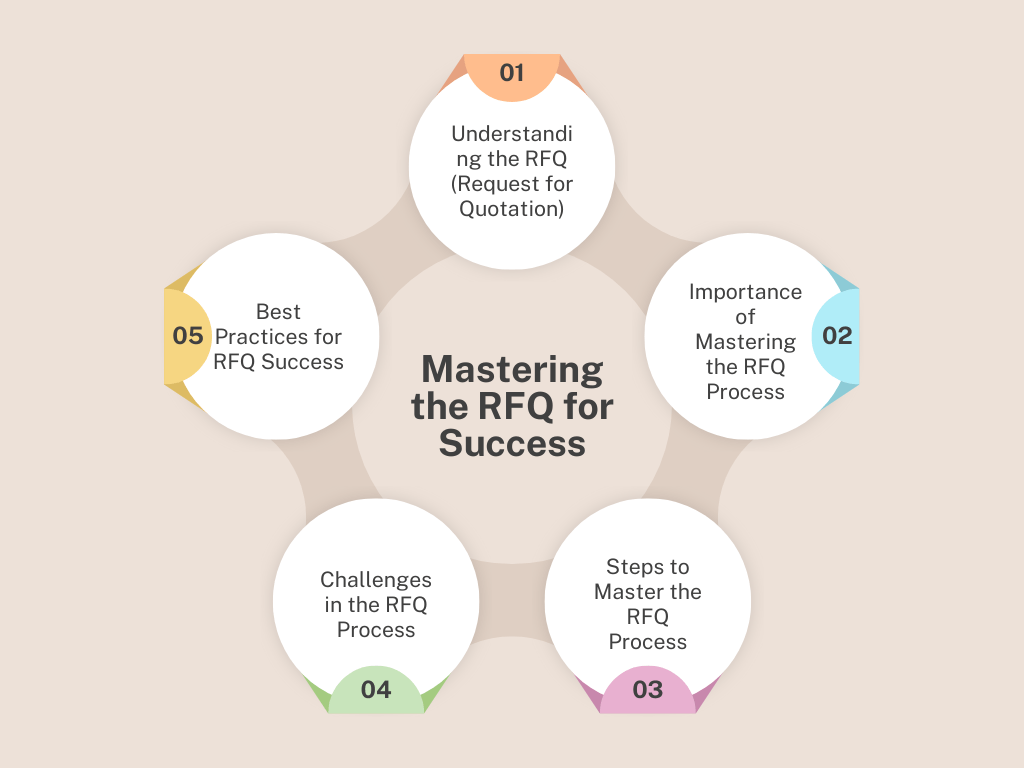In the dynamic world of procurement, the Request for Quotation (RFQ) serves as a cornerstone for securing the best value for projects and services. Whether you’re a business seeking qualified vendors or a vendor showcasing your capabilities, understanding the intricacies of an RFQ is essential. This comprehensive guide delves into everything you need to know about RFQs, empowering both businesses and vendors to navigate the process with clarity and confidence.
Unveiling the RFQ: Purpose and Process

An RFQ acts as a formal document issued by a business (the “buyer”) outlining their specific needs for a product or service. It invites vendors (the “sellers”) to submit detailed proposals outlining their qualifications, proposed solutions, and most importantly, their pricing. The buyer utilizes the RFQ responses to evaluate vendors based on various criteria, ultimately selecting the one that offers the best value proposition.
The RFQ Process: A Deep Dive into Securing the Best Value
The Request for Quotation (RFQ) acts as a cornerstone in the procurement world, facilitating a structured approach for businesses to secure the best value for their projects and services. It fosters a competitive environment where qualified vendors can showcase their capabilities and compete for the opportunity. But mastering the intricacies of the RFQ process is crucial for both buyers and vendors to navigate it effectively. This expanded exploration delves into each stage, offering insights and strategies to optimize success.

1. Identifying Needs: Defining the Project Landscape
The foundation of a successful RFQ lies in clearly identifying the buyer’s project needs. This initial stage involves meticulous planning and defining various aspects:
- Product or Service: Precisely define the desired product or service. Are you seeking a new software solution, construction services for a building renovation, or raw materials for production?
- Specifications: Outline detailed technical specifications. This might include performance requirements, compatibility needs, or specific features for the desired product or service.
- Timeline: Establish a realistic timeline for project completion, including key milestones and delivery deadlines.
- Budget Expectations: Define a preliminary budget range for the project. While flexibility might be necessary, setting a budget expectation helps vendors understand the project scope and propose solutions within a realistic cost framework.
2. Crafting the RFQ Document: Building a Roadmap for Success
Once the project needs are solidified, the buyer crafts the heart of the process – the RFQ document. This document serves as a roadmap for vendors, outlining essential information and guiding their proposal development. Here’s what a well-crafted RFQ should encompass:
- Clear Needs Description: Replicate the defined project needs from stage one in a clear and concise manner. Avoid ambiguous language and ensure all requirements are explicitly stated.
- Evaluation Criteria: Transparency is key. Outline the criteria that will be used to evaluate vendor proposals. This may include factors like pricing, qualifications, experience, proposed solutions, timeline adherence, and references.
- Submission Instructions: Provide clear and detailed instructions on how vendors should submit their proposals. This includes the deadline for submission, preferred format (digital or physical), and contact information for clarification inquiries.
3. Vendor Selection: Targeting the Right Audience
With a well-defined RFQ document in hand, the buyer strategically selects vendors to receive it. This selection process ensures that proposals are received from qualified and relevant players in the field. Here are some strategies for vendor selection:
- Pre-qualification Questionnaires: Utilize pre-qualification questionnaires to shortlist vendors based on specific criteria like industry expertise, past performance, or required certifications.
- Shortlisting based on Reputation: Leverage industry knowledge and past experiences to shortlist vendors known for their quality work and reliability.
4. Vendor Response: Showcasing Expertise and Value
Once vendors receive the RFQ, they embark on crafting compelling proposals. This is their opportunity to showcase their expertise and convince the buyer they offer the best value proposition. Here’s how vendors can create winning proposals:
- Understanding the Needs: Thoroughly analyze the buyer’s requirements outlined in the RFQ. Don’t make generic proposals – clearly demonstrate your comprehension of their specific project goals and challenges.
- Highlighting Expertise: Showcase your qualifications and experience in addressing similar projects. Quantify your successes using data and metrics to demonstrate your capabilities. Include any relevant industry certifications or awards that strengthen your credibility.
- Compelling Solutions: Don’t just reiterate the buyer’s needs. Propose innovative solutions that directly address their requirements. Be creative and showcase your unique value proposition. This might involve proposing alternative materials, efficient project management techniques, or value-added services that differentiate you from competitors.
5. Evaluation & Selection: Making the Best Choice
The buyer meticulously analyzes all received proposals based on the pre-defined evaluation criteria. Here are some key aspects considered during this stage:
- Pricing: Pricing undoubtedly plays a significant role. However, it shouldn’t be the sole deciding factor. Consider the overall value proposition each vendor offers, including quality, experience, and proposed solutions.
- Experience & Qualifications: Evaluate the vendor’s track record in handling similar projects. Assess their team’s qualifications and expertise to ensure they possess the necessary skills to deliver on their promises.
- Proposed Solutions: Analyze the feasibility and effectiveness of the proposed solutions outlined by each vendor. Consider the proposed timeline and identify potential risks or challenges associated with each solution.
- References: Reach out to references provided by the vendors to gain insights into their past performance, reliability, and ability to meet client expectations.
Negotiations might take place after the initial evaluation to refine proposals and address any outstanding questions. Ultimately, the buyer selects the vendor that offers the best overall value proposition, ensuring project success within budget and
Powering Up Your RFQ: Key Elements for Buyers

As a buyer seeking the best value, crafting an effective RFQ is critical. Here are some key elements to consider:
- Clarity & Conciseness: Clearly define your needs, avoiding ambiguous language. Ensure the RFQ is concise, allowing vendors to focus on providing relevant information.
- Detailed Specifications: Outline specific project requirements, including technical specifications, performance expectations, and deliverables. This establishes a benchmark for vendor evaluation.
- Evaluation Criteria: Clearly define the criteria for evaluating vendor proposals. This may include pricing, qualifications, experience, timeline, and proposed solutions. Transparency fosters fair and objective vendor selection.
- Submission Instructions: Provide clear instructions on how vendors should submit their proposals. This includes deadlines, preferred format, and contact information for clarification.
- Open Communication: Be open to questions from vendors during the RFQ process. This fosters clarity and ensures everyone is on the same page.
Crafting a Winning Response: A Vendor’s Guide
As a vendor seeking to secure projects, crafting a compelling RFQ response is crucial. Here are some tips to shine:
- Understanding the Needs: Thoroughly analyze the buyer’s requirements outlined in the RFQ. Clearly demonstrate your understanding of their project goals and challenges.
- Highlight Your Expertise: Showcase your qualifications and experience in addressing similar projects. Quantify your successes and highlight any relevant industry certifications.
- Compelling Solutions: Propose solutions that directly address the buyer’s needs. Be creative and showcase your unique value proposition.
- Competitive Pricing: Develop a competitive pricing strategy that considers your cost structure and aligns with the project budget.
- Clear Communication: Craft a proposal that is clear, concise, and easy to understand. Use visuals and data to support your claims.
- Meeting Deadlines: Adhere to the submission deadline outlined in the RFQ. Ensure your proposal is complete and polished.
Embracing the Collaborative Spirit
By embracing collaboration, the RFQ process can be mutually beneficial. Buyers discover new insights and expertise from qualified vendors, while vendors gain valuable exposure and potential partnerships. Open communication throughout the process fosters trust and understanding, leading to long-term, successful collaborations.
Beyond the Basics: Advanced RFQ Strategies for Optimized Success

While the core structure of the RFQ process remains consistent, implementing advanced strategies can significantly enhance its effectiveness for both buyers and vendors. Here’s a deeper dive into these strategies, empowering both parties to maximize their gains from the RFQ process.
For Buyers: Streamlining and Efficiency
- Pre-qualification Questionnaires: Go beyond simple vendor selection. Utilize pre-qualification questionnaires to shortlist vendors based on specific criteria. These questionnaires can assess aspects like industry experience, relevant certifications, past project performance metrics, and even financial stability. Shortlisting based on pre-qualification responses saves valuable time and resources by focusing on vendors most likely to meet project requirements.
- Online RFQ Platforms: Embrace technology and leverage online RFQ platforms to streamline the process. These platforms facilitate the creation, distribution, and evaluation of RFQs electronically. This improves efficiency by automating tasks like vendor notification and proposal collection. Additionally, online platforms often offer features for collaborative review and scoring of proposals, simplifying the selection process for buyers with multiple stakeholders involved.
For Vendors: Customization and Relationship Building
- Tailored Responses: Avoid generic proposals. Instead, meticulously analyze each RFQ you receive. Understand the buyer’s specific needs and project context. Tailor your response to showcase your in-depth comprehension of their unique challenges and goals. This demonstrates a genuine interest in the project and positions you as a solution-oriented partner, not just another vendor.
- Building a Strong Vendor Network: Don’t wait for RFQs to land in your inbox. Proactively cultivate relationships with potential buyers in your industry. Attend industry events, participate in relevant online forums, and network with procurement professionals. By building a strong vendor network, you increase your chances of receiving targeted RFQs that align with your expertise. Additionally, established relationships foster trust and familiarity with potential buyers, giving you an edge when competing for projects.
Beyond Efficiency: Fostering Collaboration
The RFQ process can be more than just a transactional exchange. By embracing a collaborative spirit, both buyers and vendors can achieve mutually beneficial outcomes.
- Open Communication: Encourage open communication throughout the RFQ process. Buyers can host pre-proposal clarification meetings to answer vendor questions and address any ambiguities in the RFQ. Vendors can proactively reach out to buyers for clarification or request additional information if needed. This open dialogue ensures everyone is on the same page, fostering a more transparent and collaborative environment.
- Long-Term Partnerships: The RFQ process can be a stepping stone towards developing long-term partnerships. Buyers who find a vendor that consistently delivers exceptional work can leverage the established relationship for future projects. Similarly, vendors who build trust and credibility with a buyer can secure repeat business opportunities. By viewing the RFQ as a potential beginning rather than a one-time transaction, both parties invest in establishing a foundation for a fruitful and successful collaboration.
By implementing these advanced strategies, buyers can streamline the RFQ process, identify the best value vendors, and potentially develop long-term partnerships. Vendors can increase their chances of winning projects, showcase their expertise effectively, and build valuable relationships within the industry. Remember, the RFQ process, when approached strategically and collaboratively, can be a powerful tool for achieving optimal success for both buyers and vendors.
The key differences between an RFQ and an RFI are
| Feature | Request for Quotation (RFQ) | Request for Information (RFI) |
|---|---|---|
| Purpose | To obtain pricing and terms for specific products or services. | To gather general information about suppliers’ capabilities. |
| Scope | Detailed and specific. | Broad and general. |
| Content | Includes detailed requirements, quantities, and specifications. | Includes open-ended questions to understand capabilities. |
| Stage in Procurement | Used later in the procurement process. | Used early in the procurement process. |
| Focus | Cost and terms. | Capabilities and offerings. |
| Response | Detailed quotes with prices and terms. | Informative responses about products, services, or company. |
| Decision Making | Leads to negotiations or direct procurement. | Helps narrow down potential suppliers for further evaluation. |
| Formality | Formal and specific. | Informal and broad. |
| Usage | When you know exactly what you need. | When you need to understand what is available in the market. |
| Typical Questions | Price, delivery terms, payment terms, warranties. | Company background, experience, capabilities, and product information. |
| Timeframe for Response | Shorter, as specific details are provided. | Longer, as it involves detailed and broad information gathering. |
Mastering the RFQ for Success
“Mastering the RFQ for Success” refers to the strategic and effective use of the Request for Quotation (RFQ) process to achieve business objectives, particularly in procurement and supply chain management. Here’s a detailed breakdown:

1. Understanding the RFQ (Request for Quotation):
- Definition: An RFQ is a formal document that an organization sends to vendors or suppliers asking them to submit a quote for providing a specific product or service. It’s a crucial part of the procurement process.
- Purpose: The primary goal of an RFQ is to obtain competitive bids from multiple suppliers, allowing the organization to compare prices, quality, delivery timelines, and other relevant factors.
2. Importance of Mastering the RFQ Process:
- Cost Efficiency: By sending out RFQs, businesses can ensure they get the best possible pricing for the goods or services they need. This leads to cost savings and more efficient use of resources.
- Supplier Comparison: An effective RFQ process allows businesses to evaluate multiple suppliers based on various criteria like price, quality, delivery time, and reliability, ensuring that they choose the best possible partner.
- Negotiation Power: With quotes from different suppliers in hand, businesses are in a stronger position to negotiate better terms, leading to favorable contracts.
3. Steps to Master the RFQ Process:
- Preparation:
- Clear Requirements: Clearly define the product or service specifications, including quantity, quality standards, and delivery requirements.
- Comprehensive RFQ Document: Include all necessary details such as payment terms, deadlines, and legal requirements to ensure suppliers provide accurate and comparable quotes.
- Supplier Selection:
- Identify Potential Suppliers: Research and select suppliers who have a good track record, and are capable of meeting your requirements.
- Supplier Communication: Ensure that your RFQ is clear and unambiguous. Communicate expectations and be open to questions from suppliers.
- Evaluation of Quotes:
- Comparison Criteria: Evaluate quotes based on multiple factors like cost, quality, delivery time, payment terms, and any additional services offered.
- Scoring System: Implement a scoring system to objectively compare suppliers and make informed decisions.
- Negotiation and Finalization:
- Leverage Quotes: Use the quotes received to negotiate better terms with suppliers.
- Contract Finalization: Once a supplier is selected, finalize the contract with clearly defined terms and conditions to avoid future disputes.
4. Challenges in the RFQ Process:
- Incomplete Responses: Sometimes, suppliers may not provide all the required information, making it difficult to compare quotes.
- Supplier Bias: Companies may have a preference for certain suppliers, which can affect the objectivity of the evaluation process.
- Market Fluctuations: Prices may vary due to market conditions, so timing the RFQ process is crucial.
5. Best Practices for RFQ Success:
- Detailed Documentation: Ensure that the RFQ document is thorough and leaves no room for ambiguity. Include all necessary details to get accurate quotes.
- Open Communication: Maintain clear communication with suppliers throughout the process to clarify doubts and ensure they fully understand your needs.
- Fair Evaluation: Develop a transparent and objective evaluation process to select the best supplier based on the established criteria.
- Regular Review: Continuously review and refine the RFQ process to address any shortcomings and adapt to changing market conditions.
- Strategic Impact: Mastering the RFQ process is crucial for businesses to achieve cost efficiency, ensure quality, and build strong supplier relationships.
- Continuous Improvement: Regularly updating and refining the RFQ process based on feedback and market trends can lead to long-term success in procurement and supply chain management.
By mastering the RFQ process, organizations can optimize their procurement strategies, reduce costs, and enhance overall operational efficiency.
Conclusion
The RFQ is a win-win for both buyers and vendors. Buyers find qualified vendors with innovative solutions at the best price. Vendors gain exposure and secure contracts that match their expertise. But it goes beyond that. Collaboration through the RFQ process can build long-term partnerships and even unlock a cycle of continuous improvement for both parties. By constantly refining their approaches, buyers and vendors can achieve not just project success but sustained success in a dynamic marketplace.






